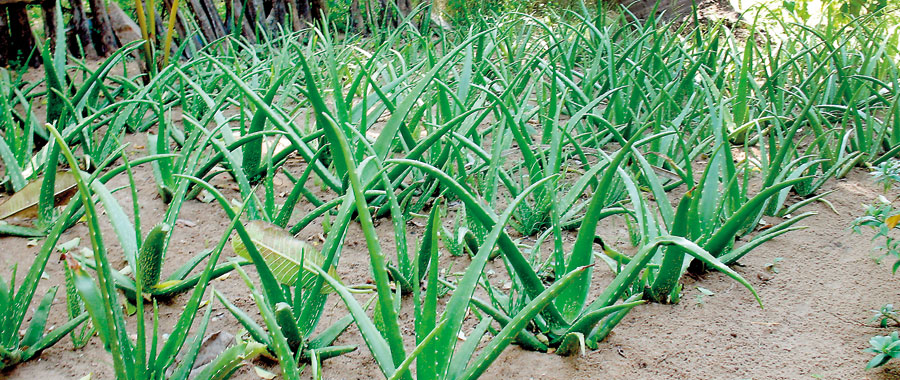Aloe vera: The wonder plant to save Puttalam lagoon
View(s):By Dr. Sriyanie Miththapala
It is an unprepossessing plant: barely two feet long, with fleshy, spindly, and spiny leaves growing in a rosette formation. Yet Aloe vera (Sinhala: Komarika; Tamil: Kariyapalam/Kathraalai) has been known through ancient history to be a valued medicinal plant. It is now also valued in the cosmetic industry.
As far back as 325 BC, Alexander the Great knew about the medicinal properties of Aloe vera, and Cleopatra is supposed to have used it as a cosmetic. The clear gel inside the succulent leaves is used widely in dermatology as treatment for topical burns, for cuts (working much like a band aid), for sunburns and for other skin ailments such as acne. It is sometimes called the ‘first aid plant’ because of these properties. It is also the base for soaps, creams, body lotions and other skin care products of the cosmetic industry.

Aloe vera cultivation in Kalpitiya. Pic by Kumudini Ekaratne, courtesy IUCN
The ancients called it ‘the plant of immortality’. These plants are touted to produce a variety of chemicals with antibacterial, anti-fungal, anti-viral and antioxidant properties that lower blood sugar and cholesterol. In Sri Lanka, Aloe vera is reported to have ‘cooling properties’ and the fresh juice is used as a cathartic and for fever, liver disease and eye disease.In recent years, drinks made of Aloe vera have been publicised as a means of reducing heartburn and improving digestion.
The demand for Aloe vera, for medicinal and cosmetic purposes has increased in recent times, both locally and internationally.
A native of Africa, Aloe vera is cultivated widely throughout the world and is popular not only because of its medicinal and cosmetic values, but also because it is hardy and can withstand water stress. Because of its resilience to drought and because it thrives in sandy soil,Aloe vera seemed like the perfect plant for cultivation in the harsh, thirsty environment of Kalpitiya, where a heavy reliance on fisheries within the Puttalam Lagoon is slowly choking its productivity.
Enter the twin players of the regional consortium Mangroves for the Future (MFF) and a local non-governmental organisation, the Marine and Coastal Resources Conservation Foundation (MCRCF). Using money disbursed in several stages by MFF (totalling about LKR2,750,000 in five separate small grants), MCRCF established a cultivation project of 30 plots using Aloe vera in the Kalpitiya area, which was to gain international recognition.
The MCRCF focussed on Kalpitya in the Puttalam district. Currently, there are about 165,000 people directly or indirectly dependent on the Puttalam Lagoon, including nearly 15,000 active fishermen, of whom nearly 6,000 fish directly in the Lagoon. It has been reported that lagoon fisheries are already one and a half times the amount that should be harvested sustainably. Land-based income-generating opportunities are limited in the area. In addition, many communities in the Kalpitiya peninsula are needy and poorly-educated. Overlaying these constraints is weak coastal management in the area, with the consequence that income-generating capacities of communities in the region are severely limited. Initiatives that generate alternative livelihoods that ease pressure on the Lagoon and to supplement fisher families’ income are, therefore, needed in the area urgently.
With funds in hand from MFF, MCRCF stepped in to address this issue. They identified 30 fisher families — focussing on the woman of the family —through four fisheries co-operative societies and set about training these women to cultivate Aloe vera in their home gardens in order to provide them with the means for alternative income generation. They selected these women based on the availability of land for cultivation, water and willingness to participate. Their focus on women meant that the MCRCF was gender sensitive and their long term objective was to discourage communities from engaging indestructive activities that affect Puttalam Lagoon and the coral reefs nearby.
The chosen fisherwomen were given in-situ training programmes on how to cultivate Aloe vera and how to prepare the land for cultivation. They were also given plants (each about 575) and manure to kick off the project.
The MCRCF negotiated with Janet Ayurveda (Pvt) Ltd for the supply, each month, of 1,500 kilogrammes of Aloe vera leaves, at fixed price. This set the foundation for a solid buy-back system operated by MCRCF that benefitted the Aloe vera growers because it was not subject to market price fluctuations. After about 3-4 months of growth, Aloe vera leaves are cut at the base and purchased (through MCRCF) by Janet Ayurveda (Pvt) Ltd. The targeted women were also given training in keeping accounts.
When it was found that the supply was greater than the demand, the excess is turned into the recently popular Aloe vera drink. For this, MCRCF trained the women, and sought the assistance of the local Public Health Inspector, who checked periodically for accepted health standards. Business approval was obtained from the Kalpitiya Pradeshiya Sabha, and a mobile selling cart set up in Kalpitiya town. This is now a popular drink of the area, for both locals and tourists.
On average, a fisher family earns 5,000-6,000 rupees per month from this Aloe vera cultivation. This is an increase of about 26% of their regular income. This may not seem much, but to an impoverished family, it is manna from heaven. It is a steady, additional income that can be used to buy long-needed items for the houseor to pay off existing loans.
One of the most important ‘by-products’ of this project is that MCRCF has set up a system of saving — in the form of a revolving fund — for these women. This is a resource that they lacked earlier. Another important outcome of the project is that many fishermen have joined the project.
The project has had several impacts. Socially, it has raised the living standards of the targeted women and increased their self-confidence by providing them with business skills. Economically, the project provides them with a stable monthly income from low-cost cultivation through a sustainable market model. Environmentally, the increase in the number of fishermen involved in the project is an indication that less time is spent fishing, meaning, however small, less pressure on fisheries resources. In addition, unproductive land is made productive through this project. It also changed attitudes: fisherwomen are now motivated to cultivate.
International recognition that the impacts of this project were worthy came in the form of an award from the SEED initiative. Founded by the United Nations Environmental Programme (UNEP), the SEED Initiative is a global partnership for action on sustainable development and the green economy. The SEED initiative supports innovative small-scale and locally-driven entrepreneurships around the globe, which integrate social and environmental benefits into their business model.
The Aloe vera cultivation project in Kalpitiya won the SEED award in 2011. With the award money, MCRCF has purchased a vehicle to increase the ambit of the project in terms of both beneficiaries and expanding the market of Aloe vera drink beyond Kalpitiya. Before, only 20 litres of drink were sold per day from the mobile cart. Now, 50 litres are sold from the vehicle, from a larger expanse of area.
The success of the project is because of the a prioricreation of market linkages by MCRCF. Without this, the sale of Aloe vera would not have been sustainable. The second reason for the success of the project is the inclusion of many players: fisheries co-operative societies, PHIs and local government officials. The project has now been replicated in Panama with just eight cultivators. Here the Aloe vera is being only used to make drinks which will be sold from a mobile cart. Due to commence in March 2013, this effort will target communities and tourists in Pottuvil and Arugambay.
It all started with a small grant from MFF, but has ended in large gains for a community.
MFF: What’s it all about
Mangroves for the Future(MFF) is an regional initiative comprising a consortium of international intergovernmental organisations such as IUCN, International Union for Conservation of Nature, the United Nations Development Programme (UNDP), the United Nations Food and Agriculture Organization (FAO) and the United Nations Environment Programme (UNEP), as well as CARE International and Wetlands International (WI). MFF seeks to achieve demonstrable changes and results across four key areas of influence: regional cooperation, national programme support, private sector engagement, and community action. The MFF Small Grants Facility (SGF) is a window for financing sustainable, local level initiatives in coastal areas, through small grants. The main objectives of the SGF are to finance small projects to support local community action for the restoration and management of coastal ecosystems and their use on a sustainable basis.
MCRCF was founded in 2006 by a group of environmental enthusiasts in Sri Lanka who had long been active in marine and coastal resources conservation. MCRCF works on coral reef and mangrove conservation and introducing alternative livelihoods, working closely with fishing communities, other NGO’s and the fisheries community-based organisations in the country. MCRCF is committed to make a difference in the lives of the coastal communities and to eradicate poverty among coastal communities.
Follow @timesonlinelk
comments powered by Disqus

















